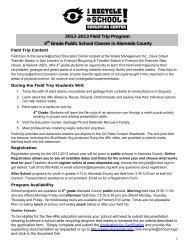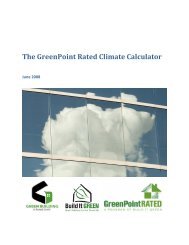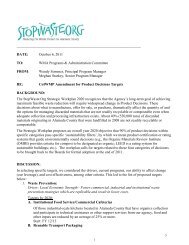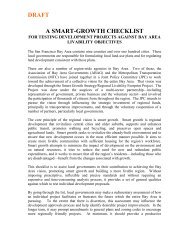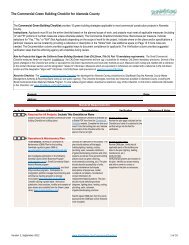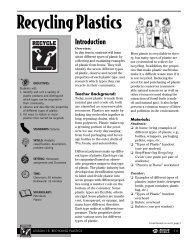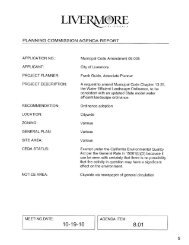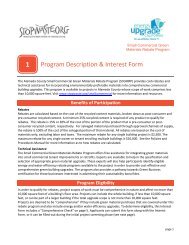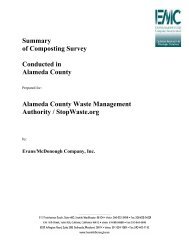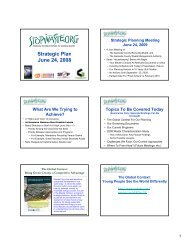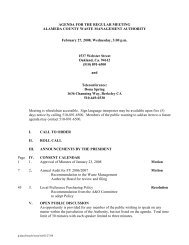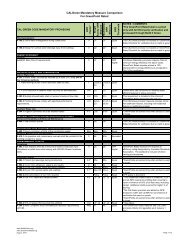Bay-Friendly Landscaping Principles and Practices - StopWaste.org
Bay-Friendly Landscaping Principles and Practices - StopWaste.org
Bay-Friendly Landscaping Principles and Practices - StopWaste.org
Create successful ePaper yourself
Turn your PDF publications into a flip-book with our unique Google optimized e-Paper software.
4. Conserve Water<br />
C<br />
alifornia’s climate includes long dry summers <strong>and</strong> the periodic failure of winter rains — water is a precious<br />
<strong>and</strong> often scarce resource. With projected population growth, it is estimated that by 2020 the state will<br />
face annual water shortages, even during years of regular rainfall.<br />
Yet one-third of all urban water is applied to l<strong>and</strong>scapes. What’s more, much of this water is used in excess or at<br />
the wrong time of year: residential properties are regularly over-watered by 30-40%.<br />
Water-wise l<strong>and</strong>scaping is, however, more than efficient irrigation <strong>and</strong> xeriscapes. It also means augmenting<br />
the water holding capacity of the soil to create drought resistant soils. Water-wise l<strong>and</strong>scaping makes use of<br />
alternatives to potable water such as recycled water, graywater, or captured rain. And, it relies on the latest in<br />
irrigation controller technology for the most efficient application of water possible. The l<strong>and</strong>scape professional can<br />
offer the following critical expertise in conserving water:<br />
<strong>Principles</strong><br />
& <strong>Practices</strong><br />
1. Create drought resistant<br />
soils with compost & mulch<br />
Description<br />
A robust, living soil, with sufficient <strong>org</strong>anic<br />
content, is the foundation of a water<br />
conserving l<strong>and</strong>scape: 1 cubic foot of soil<br />
holds roughly 1.5 quarts of water for each<br />
1% of <strong>org</strong>anic matter. The amount of<br />
irrigation water required for a l<strong>and</strong>scape<br />
thus varies significantly with soil quality.<br />
Applications<br />
n Know the soil texture.<br />
n Incorporate 2-4 inches of compost<br />
into the top 6-12 inches of soil to<br />
reach a target soil <strong>org</strong>anic matter of<br />
3.5% under turf <strong>and</strong> 5% in planting<br />
beds.<br />
n Topdress with compost around shrubs<br />
<strong>and</strong> trees, <strong>and</strong> on turf.<br />
n Regularly apply mulch to all exposed<br />
surfaces to encourage living soils <strong>and</strong><br />
reduce evaporation.<br />
n For additional practices see Nurture the<br />
Soil in these guidelines.<br />
n Finally, consider applying high quality<br />
mycorrhizal innoculants, available as<br />
root dips, mixes, tablets <strong>and</strong> solutions.<br />
2. Grow drought tolerant CA native or Mediterranean plants<br />
Description<br />
California native plants have evolved<br />
with local ecosystems <strong>and</strong> adapted to<br />
our soils, wildlife <strong>and</strong> climate — including<br />
no rain for 6 months of the year. Many<br />
natives, as well as many Mediterranean<br />
species, tolerate dry summers without<br />
watering once they are established.<br />
Applications<br />
n Keep in mind that California’s climate<br />
<strong>and</strong> soil can vary significantly, as can<br />
native plant species. Not every native<br />
is drought tolerant: some, like Salix<br />
spp. (Willows) <strong>and</strong> Populus fremontii<br />
(Cottonwood), need moist soil. Select<br />
the native species that match the site<br />
soil <strong>and</strong> microclimate <strong>and</strong> if possible,<br />
choose local ecotypes.<br />
n Or select plants from Mediterranean<br />
climates that also thrive with little<br />
irrigation.<br />
n Plant in fall so the plants can establish<br />
their root system during the rainy<br />
season <strong>and</strong> require less water their<br />
first dry season.<br />
n Water drought tolerant species for<br />
their first one or two summers, until<br />
they are established.<br />
n Minimize high water use ornamentals.<br />
Benefits<br />
Appropriately sited native or<br />
Mediterranean type plants often require<br />
less soil preparation, watering, mowing,<br />
fertilizing <strong>and</strong> spraying, which can reduce<br />
your operating costs. CA native species<br />
are relatively easy <strong>and</strong> inexpensive to<br />
implement on a trial basis. Using local<br />
natives reduces the risk of spreading nonlocal<br />
plant species.<br />
Benefits<br />
Compost can increase permeability <strong>and</strong><br />
water-holding capacity, thereby reducing<br />
the need for irrigation <strong>and</strong> lowering<br />
water bills.<br />
<strong>L<strong>and</strong>scaping</strong> with natives <strong>and</strong> Mediterranean plants require little or no irrigation once<br />
established <strong>and</strong> provide a sense of the seasons.<br />
PHOTO: Richard Rollins<br />
34<br />
3



